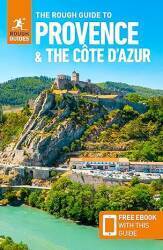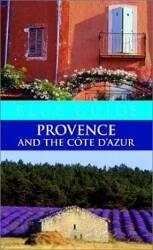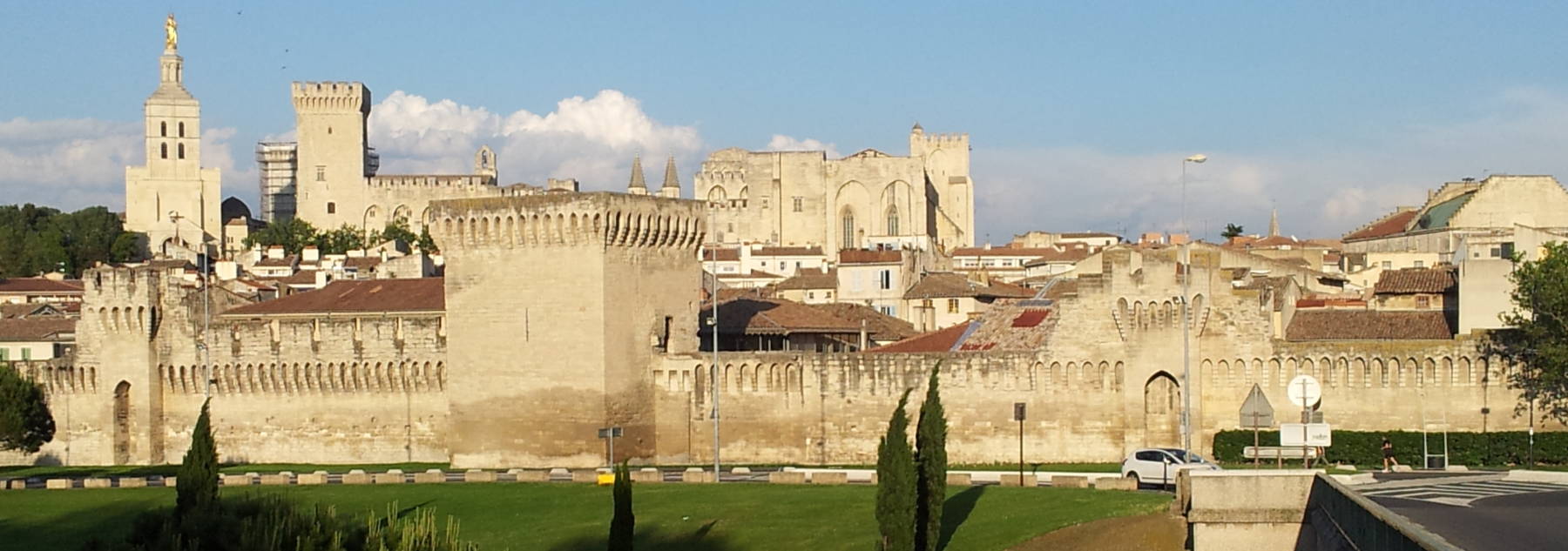
The Avignon Papacy
The Pope Relocates to Avignon
Avignon CorruptPopes
We're visiting Avignon, and we just saw how corrupt the medieval Papacy had become. The Popes had become involved in politics, and national leaders had been manipulating the Papacy. It had been strictly Italian, and specifically Roman, for centuries. Now the King of France wanted to take control.
Pope Benedict XI, an Italian, was in office for just eight months. The College of Cardinals had wanted a Pope who wouldn't be overly hostile toward the King of France. Benedict had un-excommunicated the King (excommunicated by his predecessor Boniface VIII), but within a year he had excommunicated many powerful figures close to the King. Benedict had died suddenly and suspiciously at Perugia. The French King's minister Guillaume de Nogaret was suspected of having poisoned Benedict.
There was a Popeless gap of a year while the French and Italian cardinals quarreled. They finally selected Raymond Bertrand de Got, born in Villandraut, Aquitaine. For a Papal candidate he was, unusually, neither Italian nor a cardinal. But he was a friend of the King of France.
He took the name Pope Clement V. He was at Bordeaux when he was formally notified of his election to the Papacy, and told to travel to Italy. But he selected Lyon for his coronation in 1305. He immediately created nine new French cardinals, providing a numerical advantage for France in the next conclave.
In 1306 and 1307 he withdrew Boniface's Papal bulls that asserted Papal authority over all national leadership.
Philip IV had been charging the Knights Templar with usury, credit inflation, fraud, heresy, sodomy, immorality, and other abuses. So, later in 1307 Clement had hundreds of them arrested in France.
The Move to Avignon
Clement's Papal court had been at Poitiers, in west-central France to the north of Clement's home. In March 1309 he moved his court to Carpentras, near Avignon. The territory was officially part of the Kingdom of Arles within the Holy Roman Empire. However, the French King controlled the land on the opposite bank of the Rhône and had stronger influence over the Vaucluse than the remote Emperor in German-speaking territory far to the north.
King Philip IV leaned hard on Clement, pressuring him into subjecting Boniface VIII, dead for six years now, to a posthumous trial for heresy, later expanded to include sodomy. Clement pardoned Guillaume Nogaret for offenses against Boniface and the church, de-excommunicating Nogaret on the condition that he go to the Holy Land and serve with the next wave of soldiers. Clement also formally excused the King for everything he had said and done against Boniface, and he later officially disbanded the Order of the Knights Templar.
Clement's successor moved the Papal court into Avignon itself. Below we see the medieval walls of the city surrounding the opulent Palace of the Popes.
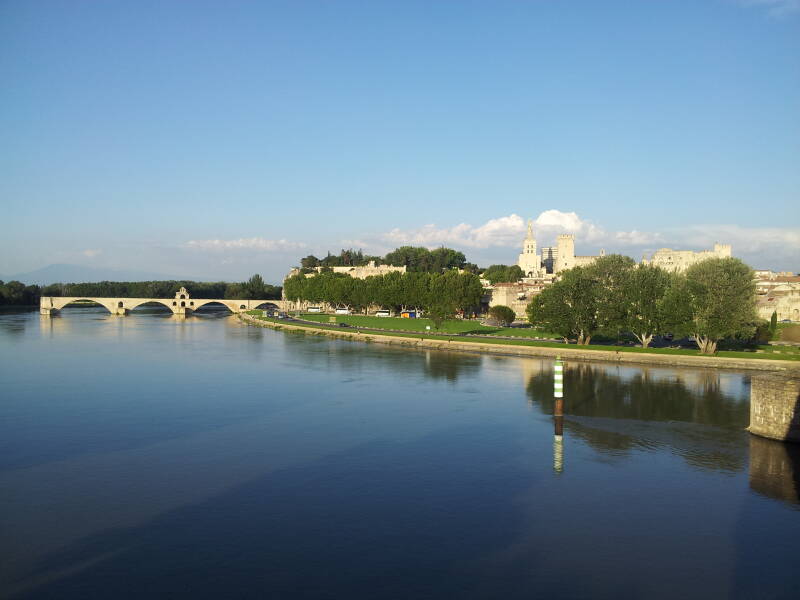
Rhône river, the Pont d'Avignon, and the Palace of the Popes within the medieval walls of Avignon.
Beginning the "Babylonian Exile"
Jacques Duèze had studied medicine on Montpellier in southern France, and law in Paris, and taught both canon and civil law. He became Bishop of Fréjus in 1300, and transferred to Avignon in 1310.
Pope Clement V died in 1314. Although he had stacked the deck with several added French cardinals, there was another Popeless interregnum for two years. King Philip finally set up a conclave of 23 cardinals in Lyon. They elected and crowned Duèze, who took the name Pope John XXII.
John XXII felt that the Spirituals movements had too much enthusiasm for the concepts of the Absolute Poverty of Christ and Apostolic Poverty. He officially condemned the pro-poverty group known as the Fraticelli in 1317. In 1322 he convened a group of experts to study (meaning "reject") the idea that Christ and the apostles owned nothing. There was some disagreement, apparently not everyone had gotten the message that the Pope had a definite outcome in mind. But, the majority rejected the idea, as it would condemn the church's right to own property and treasures. The followers of Francis of Assisi objected, but the Pope issued a bull declaring the doctrine that Christ and his apostles had no possessions to be "erroneous and heretical". He later issued other bulls declaring that he was correct, and earlier bulls asserting poverty were actually wrong.
Today's TV fund-raisers preachers are firmly on the side of Pope John XXII.
Amazon
ASIN: 0190876735
Amazon
ASIN: 159349601X
Some came to refer to the Avignon Papacy as the "Babylonian Exile" of the church. Those in Avignon agreed, because didn't they have it rough in a city that hadn't been capital of an empire? But it was intended as criticism — the "exile" was in a city rapidly becoming more and more opulent, like Babylon at its peak.
The Avignon Popes used gold and silver dishes at banquets, and wore expensive outfits. Churches were billed an annual tithe or 10% on property; first years' salaries for bishops were taken as annates, and pardons were sold along with dispensations to allow illiterate men to become priests and for converted former Jews to visit unconverted parents.
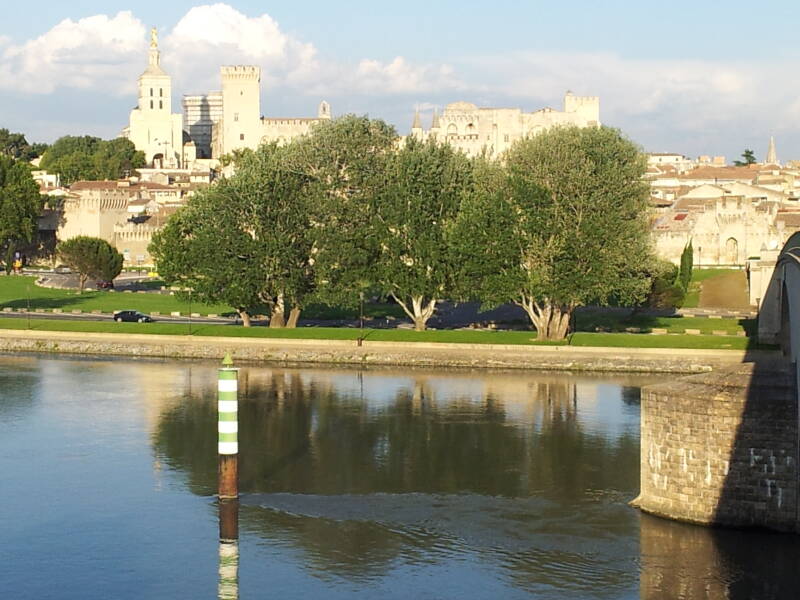
In 1348 Clement bought the town of Avignon from Joanna I, Queen of Naples and Countess of Provence, for 80,000 florins.
The Papal library in Avignon became the largest in Europe in the 14th century, with 2,000 volumes.
Pope Boniface VIII had formed the University of Avignon from the existing schools in the city in 1303.
In 1413 Antipope John XXIII founded the university's department of theology. It remained quite small a long time. In the 16th and 17th centuries the university developed a department of medicine. The university dwindled during the chaos of the Revolution, and it was closed down and abandoned in 1792.
An annex of the Faculté des Sciences d'Aix-Marseille was created in Avignon in 1963. It was gradually improved over the following two decades. In 1984 the Université d'Avignon et des Pays de Vaucluse was established. Located within the old city walls, now has a little over 7,000 students.
Amazon
ASIN: 1933346329
Amazon
ASIN: 0674971841
The stone Pont Saint-Bénézet, commonly called the Pont d'Avignon, originally had twenty-one piers. Only four remain, and the bridge ends out in the middle of the river.
A bridge was built here between 1177 and 1185, possibly all wooden, or maybe wood spans between stone piers. It was destroyed in 1226 during the Albegensian Crusade, when King Louis VIII of France besieged Avignon.
The bridge had strategic significance. It was the only river crossing between the territories controlled by the Pope and by the King of France. It was also the only bridge across the Rhône from Lyon all the way downstream to the Mediterranean.
The all-stone bridge was started in 1234. It was abandoned in the mid 1600s, because arches would collapse during major floods of the Rhône. It was missing four of its 22 arches by 1644. A large flood in 1669 carried away more of the bridge. More arches have collapsed or been demolished over the years, so only four arches remain today.

The first few Avignon Popes built the walls around the city. They look impressive but they're made of soft limestone. The Popes relied on their palace, the Palais des Papes. It's built on the Rocher des Doms, the 35-meter-tall stone outcropping, and its walls are five and a half meters thick.
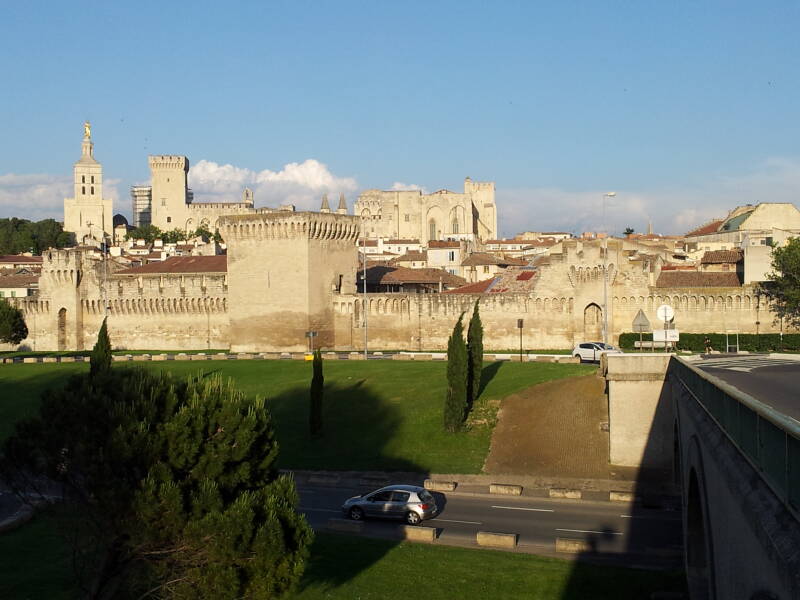

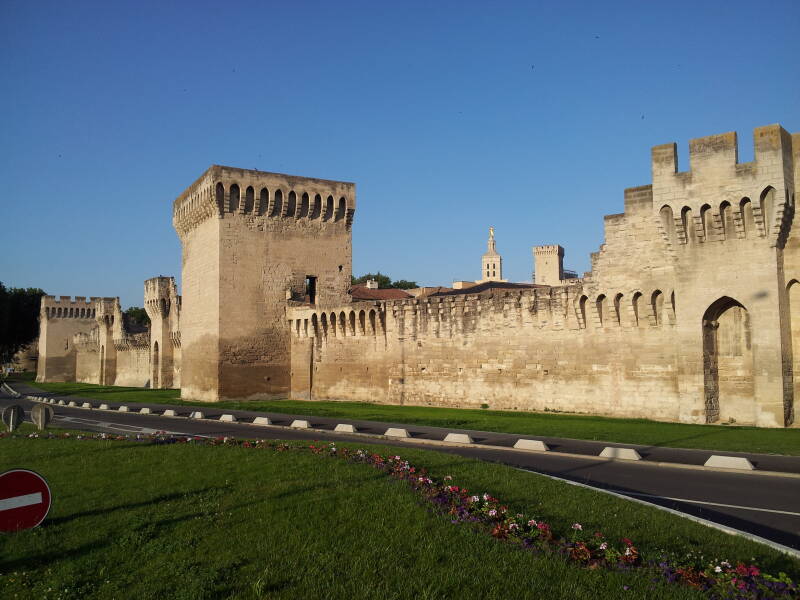
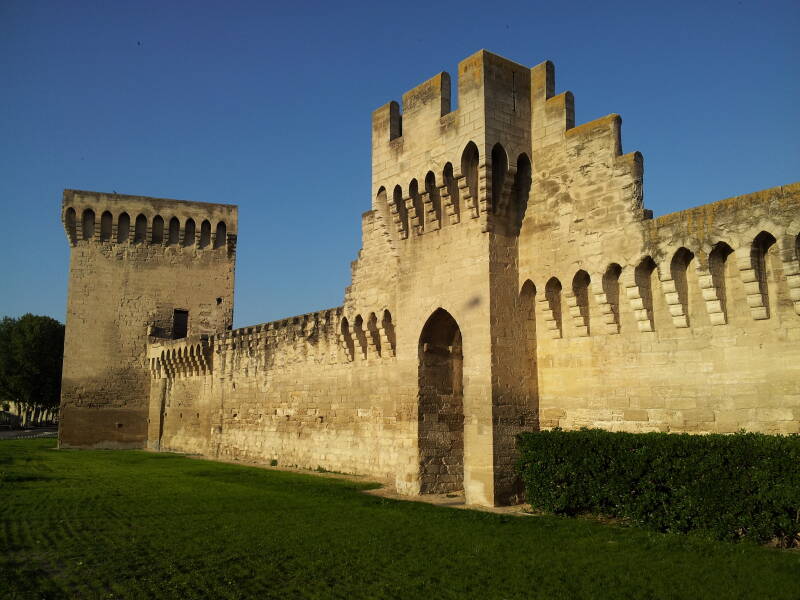
Notre Dame des Doms, the cathedral, was mostly built in the 12th century. It's to the left in the below picture. Its bell tower was rebuilt in 1425, topped by a gilded statue of the Virgin Mary in 1859.
The Palais des Papes, the Palace of the Popes, is the large building to its right. This is just a small segment at one end. it's the largest medieval Gothic palace in Europe.
Pope Benedict XII (in office 1334-1342) built the Old Palace on the high Rocher des Doms, where the old episcopal palace of the Bishops of Avignon had stood. His successor Pope Clement VI (1342-1352) extended this by building the New Palace. It occupied an area of 11,000 square meters (or 118,400 square feet) by the time it was finished.

The enormous size allowed the church bureaucracy to grow. The Curia, the Papal administration, had 200 employees in the late 1200s. It was over 300 by 1300, and had grown to 500 by 1316. In addition to this, there were over 1,000 lay officials working within the Palace for the Pope's administration. Successive Popes continued reconstruction until 1364, adding towers to put their personal signatures on it.
The Palace remained under Papal control until the French Revolution, when it was already in bad shape before being sacked by Revolutionaries. Like many historic sites, it became a prison under Napoleon. It became a museum in 1906.
The Avignon Papacy began in 1309.
Seven Popes resided here:
• Clement V (1305-1314)
• John XXII (1316-1334
• Benedict XII (1334-1342)
• Clement VI (1342-1352)
• Innocent VI (1352-1362)
• Urban V (1362-1370)
• Gregory XI (1370-1378)
Urban V decided to return the Papacy to Rome. Rome had really gone downhill. When Clement moved to Avignon, Rome had become uncontrollable. The city was filled with battles between the military forces of aristocratic Roman families. The Lateran Basilica, the cathedral church of Rome and the seat of the Roman pontiff, had been destroyed in a fire. The Papal States had been entrusted to a team of three cardinals who were loosely controlling the territory. Papal military forces were fighting the Venetian army. Urban turned around and returned to Avignon.
Pope Gregory XI, just as French as the other six Avignon Popes before him, also planned to return the Papacy to Rome. He managed to pull that off, arriving in January of 1377. However, he died just over a year later, in March 1378. That led to the Western Schism.

Two Popes At Once
Romans rioted after Pope Gregory XI died, demanding that the next Pope had to be from Rome. But, there was no one in Rome remotely qualified for the job.
The cardinals elected Bartolomeo Prignano from Naples, who was the Archbishop of Bari. He took the throne as Pope Urban VI.
He had been a good administrator in the offices in Avignon, but he wasn't suited to be Pope. He was suspicious and prone to fits of rage. Most of the cardinals who had just elected him regretted their choice. The majority of them left for Anagni, a hill town southeast of Rome, where they had a new conclave and elected a rival Pope.
Pope #2, Robert of Geneva, took the name Clement VII. Since Rome was occupied and Avignon was all set up, he went to Avignon.
This was a mess. There had been Antipopes before, claimants to the Papal throne. But this time there were two Popes selected by the same group of church leaders. National leaders had a choice of two Popes.
| Avignon: Clement II | Rome: Urban VI |
| Denmark, England, Flanders, Holy Roman Empire, Hungary, Ireland, Norway, Portugal, Poland(-Lithuania), Sweden, Republic of Venice and other northern Italian city-states | France, Burgundy, Savoy, Aragon, Castile and León, Naples, Cyprus, Scotland, Wales |
When each died, their faction selected a replacement. Boniface IX (1389-1404) in Rome and Benedict XIII (1394-1423) in Avignon.
When Boniface died in 1404, the 8 cardinals backing him offered to not elect a new Pope if Benedict would step down, although what was supposed to happen then? Benedict of course refused. So now there was a new Pope Innocent VII in Rome.
| Avignon | Rome |
| Clement VII (1378-1394) | Urban VI (1378-1389) |
| Benedict XIII (1394-1423) | Boniface IX (1389-1404) |
| Innocent VII (1404-1406) |
Amazon
ASIN: B095CWJRBS
Amazon
ASIN: B075L8J4L9
You may be ready for a pastis. It's an anise-flavored apéitif especially popular in southeastern France. It's a liqueur, bottled with sugar.
It's served neat with a small jug of water. You blend it to your taste, usually 5:1 water to pastis. The drop in alcohol content from the original 40–45% brings the terpene oils out of solution. The drink changes from dark but transparent yellow to a light yellow cloudy liquid.

Pisa Adds a Third Pope
The word nepotism comes from the pattern of Popes giving powerful positions to their nephews.
Gregory XII had already created four new cardinals in 1408, two of them his nephews, despite promising before his election to keep things as they were. The existing cardinals complained, and refused to attend the service where the four new cardinals would be installed. One of the protesting cardinals left for Pisa.
The Pope sent one of his nephews, along with military backup, to seize the absent cardinal and bring him back by force. That caused seven more cardinals to leave immediately, followed by another who was just arriving.
The protesting cardinals published a manifesto calling for a general council in Pisa in 1409, hoping to end the schism. Pope Benedict XIII in Avignon called for a council of his own. The Roman Pope Gregory XII said that he that was also going to have an independent council, but he fled with the one cardinal that remained faithful to him.
The Universities of Paris, Oxford, and Cologne, along with many distinguished scholars of church law, sent delegates to Pisa in support of the protesting cardinals. Royal leaders, on the other hand, no longer had to care as they no longer relied on the support of the rival Popes.
The College of Cardinals, the supporters of both Rome and Avignon, met for the Council of Pisa in March 1409. They hoped to end the Western Schism by deposing both Benedict XIII in Avignon and Gregory XII in Rome. As there was no one undisputed pope to call for a general council, the Holy See should be considered vacant. It was up to them to elect an undisputed pope. They were 22 cardinals, 80 bishops, and 4 patriarchs, plus representatives of 100 bishops and 87 abbots who couldn't make it to Pisa, plus 300 doctors of theology or canon law, plus ambassadors from all the Christian nations. They were meeting under the presidency of a cardinal who had been named before the Schism had begun. What could possibly go wrong?
"This will be easy", they figured. "Accuse them both of schism and manifest heresy, they will step down, and we'll elect a single replacement."
It did not go well.
When they finally got around to reading the document listing all the charges against the two Popes, it took over three hours.
Two months later the Patriarch of Alexandria read the group's decision. Benedict XIII and Gregory XII were schismatics, notorious heretics, guilty of perjury, violators of promises, and unworthy of the office of Pope. They were forbidden to consider themselves as Supreme Pontiffs, and everything they had done was annulled. The seat of the Holy See was declared to be vacant.
Everyone at the council was happy, but Benedict and Gregory had no plans of going along with the decision.
The cardinals in Pisa then elected a new Pope, Alexander V.
Now there were three Popes — Benedict XIII in Avignon, Gregory XII in Rome, and Alexander V in Pisa.
One common complaint about the Council of Pisa (in addition to adding a third Pope) was that they weren't necessarily authoritative. If bogus Popes appoint a group of bogus cardinals, can those bogus cardinals really elect a true Pope to replace the two bogus Popes?
But for now, the Pisa line of Popes continued. England, France, Bohemia, Portugal, parts of the Holy Roman Empire, and some Italian city-states recognized the Popes of Pisa.
| Avignon | Rome | Pisa |
| Clement VII (1378-1394) | Urban VI (1378-1389) | Alexander V (1409-1410) |
| Boniface IX (1389-1404) | ||
| Benedict XIII (1394-1423) | Innocent VII (1404-1406) | |
| Gregory XII (1406-1415) | John XXIII (1410-1415) |
The Council of Constance in 1414-1418 finally straightened things out. Somehow they managed to make the case that all three of the current Popes were invalid, and they were going to elect one that would be the One True Pope. That was Martin V.
Pope Benedict XIII (Avignon) simply refused to accept the decision of the Council of Constance. The Holy Roman Emperor sent representatives, joined by diplomats of several nations, but Benedict said he was still the Pope. Eventually, when Martin V was elected Pope, meant to be the only one, Benedict fled to a castle in the Kingdom of Aragon. Only the Kingdom of Aragon recognized his claim. He stayed there, insisting he was the Pope, until he died in 1423.
Pope John XXIII (Pisa) attended the Council of Constance, at least for a while. Things quickly turned against the idea of a Third Pope. Disguised as a postman, John XXIII fled downriver along the Rhine, accompanied by Frederick IV, Duke of Austria. He was forcibly returned to the council, where he was tried and found guilty for heresy, simony, schism, and immorality. Gibbon's The Decline and Fall of the Roman Empire reports: "The more scandalous charges were suppressed; the vicar of Christ was accused only of piracy, rape, sodomy, murder and incest." Gibbon was always grinding his anti-religion ax, but you do wonder what all John XXIII got up to. John was imprisoned in Germany, but ransomed by the Medici.
Gregory XII (Rome) was the only one with a graceful end. He was convinced to resign, and retired from public life. His was the last Papal resignation until Benedict XVI in 2013.
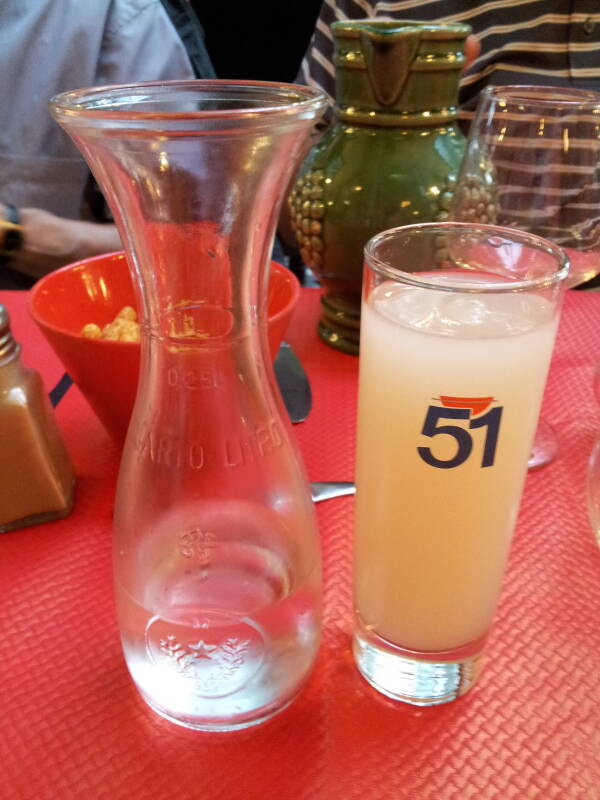
Avignon After the Popes
Avignon and the surrounding territory continued to be Papal possessions until the French Revolution. The Hôtel des Monnaies, the Papal mint, was built in 1610.
However, the French Kings maintained a large military garrison directly across the Rhône at Villeneuve-lès-Avignon. Starting in the 1400s, the French Kings ruled Avignon as a part of their kingdom. Cardinal Richelieu was exiled to Avignon in 1618.
After the French Revolution, France expanded. Avignon and Comtat-Venaissin were combined with the former principality of Orange in 1793, forming the French département of Vaucluse. In 1814, the Pope recognized the annexation of Avignon.
Continue visiting Avignon:
Or, somewhere else in France:
